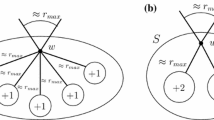Abstract
A network is called nonblocking if every unused input can be connected by a path through unused edges to any unused output, regardless of which inputs and outputs have been already connected. The Beneš network of dimension n is shown to be strictly nonblocking if only a suitable chosen fraction of 1/n of inputs and outputs is used. This has several consequences. First, there is a very simple strict sense nonblocking network with N = 2n inputs and outputs, namely a (n + log n + 1)-dimensional Beneš network. Its depth is O(log N), it has O(N log2 N) edges and it is not constructed of expanders. Secondly it leads to a (3 log N)-competitive randomized algorithm for a (log N)-dimensional Beneš network and a O(log2 N)-competitive randomized algorithm for a (log N)-dimensional hypercube, for routing permanent calls.
This research has been supported by the Grant Agency of the Czech Republic under grant No. 102/97/1055 and by European Community under project ALTEC-KIT INCO-COP 96-0195.
Access this chapter
Tax calculation will be finalised at checkout
Purchases are for personal use only
Preview
Unable to display preview. Download preview PDF.
Similar content being viewed by others
References
S. Arora, F. T. Leighton, and B. M. Maggs. On-line algorithms for path selection in a nonblocking network. SIAM Journal on Computing, 25(3):600–625, June 1996.
B. Awerbuch, Y. Bartal, A. Fiat, and A. Rosén. Competitive non-preemptive call control. In Proceedings of SODA, pages 312–320, 1994.
B. Awerbuch, R. Gawlick, T. Leighton, and Y. Rabani. On-line admission control and circuit routing for high performance computing and communication. In Proceedings of FOCS, pages 412–423, 1994.
L. A. Bassalygo and M. S. Pinsker. Complexity of an optimum nonblocking switching network without reconnections. Problems of Information Transmission (translated from Problemy Peredachi Informatsii (Russian)), 9:64–66, 1974.
B. Beizer. The analysis and synthesis of signal switching networks. In Proceedings of the Symposium on Mathematical Theory of Automata, pages 563–576. Brooklyn, NY, Brooklyn Polytechnic Institute, 1962.
V. E. Beneš. Permutation groups, complexes and rearrangeable connecting network. The Bell System Technical Journal, 43,4:1619–1640, 1964.
D. G. Cantor. On non-blocking switching networks. Networks, 1:367–377, 1972.
P. Feldman, J. Friedman, and N. Pippenger. Wide-sense nonblocking networks. SIAM Journal on Discrete Mathematics, 1, 1988.
J. A. Garay, I. S. Gopal, S. Kutten, Y. Mansour, and M. Yung. Efficient on-line call control algorithms. In Proceedings of the 2nd Israeli Symposium on Theory of Computing and Systems, pages 285–293, 1993.
J. Kleinberg and R. Rubinfeld. Short paths in expander graphs. In Proceedings of FOCS, pages 86–95, 1996.
J. Kleinberg and É. Tardos. Approximations for the disjoint paths problem in high-diameter planar networks. In Proceedings of STOC, pages 26–35, 1995.
F. T. Leighton. Introduction to Parallel Algorithms and Architectures: Arrays-Trees-Hypercubes. Morgan Kaufmann, San Mateo, 1992.
R. J. Lipton and A. Tomkins. Online interval scheduling. In Proceedings of SODA, pages 302–311, 1994.
R. Melen and J. S. Turner. Nonblocking multirate networks. SIAM Journal on Computing, 18(2):301–313, 1989.
C. E. Shannon. Memory requirements in a telephone exchange. Bell Syst. Tech. Journal, 29:343–349, 1950.
J. Turner and N. Yamanaka. Architectural choices in large scale atm switches. Technical Report WUCS-97-21, Department of Computer Science, Washington University Saint Louis, 1997.
A. Waksman. A permutation network. Journal of the ACM, 15(1):159–163, January 1968.
Author information
Authors and Affiliations
Editor information
Editors and Affiliations
Rights and permissions
Copyright information
© 1998 Springer-Verlag Berlin Heidelberg
About this paper
Cite this paper
Kolman, P. (1998). On Nonblocking Properties of the Beneš Network. In: Bilardi, G., Italiano, G.F., Pietracaprina, A., Pucci, G. (eds) Algorithms — ESA’ 98. ESA 1998. Lecture Notes in Computer Science, vol 1461. Springer, Berlin, Heidelberg. https://doi.org/10.1007/3-540-68530-8_22
Download citation
DOI: https://doi.org/10.1007/3-540-68530-8_22
Published:
Publisher Name: Springer, Berlin, Heidelberg
Print ISBN: 978-3-540-64848-2
Online ISBN: 978-3-540-68530-2
eBook Packages: Springer Book Archive





